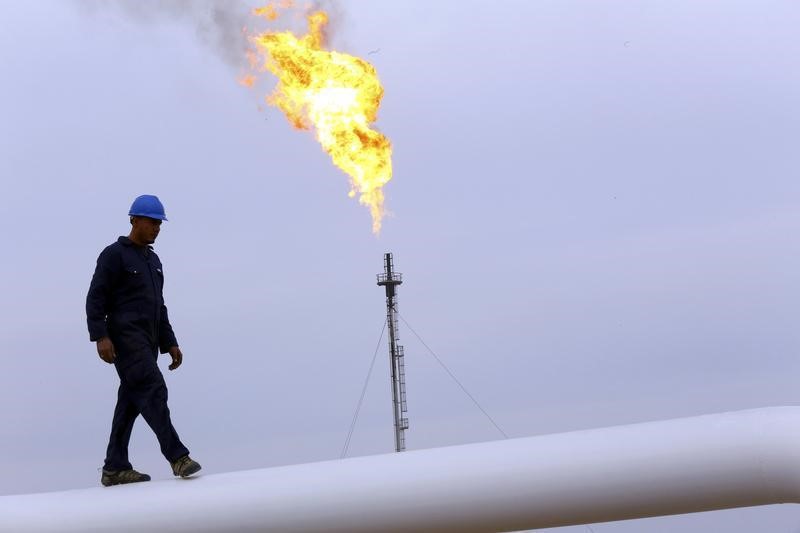Bulls fight to get U.S. oil to $80 before Powell speaks on inflation, rates

LCO
-0.63%
Add to/Remove from Watchlist
Add to Watchlist
Add Position
Position added successfully to:
Please name your holdings portfolio
Type:
BUY
SELL
Date:
Amount:
Price
Point Value:
Leverage:
1:1
1:10
1:25
1:50
1:100
1:200
1:400
1:500
1:1000
Commission:
Create New Watchlist
Create
Create a new holdings portfolio
Add
Create
+ Add another position
Close
CL
-0.63%
Add to/Remove from Watchlist
Add to Watchlist
Add Position
Position added successfully to:
Please name your holdings portfolio
Type:
BUY
SELL
Date:
Amount:
Price
Point Value:
Leverage:
1:1
1:10
1:25
1:50
1:100
1:200
1:400
1:500
1:1000
Commission:
Create New Watchlist
Create
Create a new holdings portfolio
Add
Create
+ Add another position
Close
By Barani Krishnan
Investing.com — Oil bulls’ determination to get U.S. crude to above $80 per barrel was on full display Monday as they plowed in to rescue a market that plunged almost 2% on inflation and rate hike fears ahead of Federal Reserve chair Jay Powell’s testimony to Congress.
New York-traded West Texas Intermediate settled at $80.46, up 78 cents, or 1%. It was the U.S. crude benchmark’s first close above $80 in three weeks.
“It’s obvious what’s going on here,” said John Kilduff, partner at New York energy hedge fund Again Capital. “Supply fears are being ratcheted up to justify $80-and-above WTI pricing for the spring and it’s being done ahead of what is likely to be a hawkish call on rates by Powell.”
Ed Moya, analyst at online trading platform OANDA, concurred, saying the market was trading on the premise that there were “too many upside risks” on the supply front, and that could bolster the case for $80 WTI.
London-traded Brent crude settled at $86.18, up 35 cents, or 0.4%. The last time the global crude benchmark settled above $86 was on Feb. 16.
Helping oil’s climb was a regurgitated forecast from Goldman Sachs, originally made at the start of the year, that a barrel will get to above $100 by December. While there are another nine months to go before that forecast can be verified, oil bulls found it just to push the market up on Monday on that rehashed Goldman call.
Earlier in the season, both WTI and Brent fell more than $1 after China’s Congress forecast a 5% GDP growth target for 2023, versus market expectations for 6.0%. China is the world’s top importer of crude.
Markets also hunkered down on a slew of cues on U.S. monetary policy expected in back-to-back addresses to Congress and Senate by Powell on Tuesday and Wednesday. Across markets, traders are also wary about the U.S. non-farm payrolls report for February, due on Friday from the Labor Department.
Powell’s comments to Congress and Senate will be closely followed for hints on whether a larger rate hike is under consideration this month after recent data pointing to still persistent inflation. Powell has said the January jobs report showed why the battle against inflation will «take quite a bit of time».
Friday’s employment report for February will be the last before the Fed’s upcoming meeting on March 21-22 and takes on extra significance after January’s blowout report prompted investors to reevaluate expectations for the future path of interest rates.
Expectations are for the economy to have added 200,000 jobs last month, moderating from January’s blistering jobs growth of 517,000, while the unemployment rate is expected to hold steady at a more than five-decade low of 3.4%.
Another stronger-than-expected report could stoke fears of more hawkish Fed action — strong demand in the labor market bolsters wage growth, which contributes to higher inflation — keeping pressure on the Fed to push rates higher.
The Consumer Price Index, a broad gauge of inflation, hit a 40-year high of 9.1% for the year to June 2022. It has moderated since to an annualized growth of 6.4% in January but remains well above the Fed’s target of just 2% per year.
To clamp down on runaway price growth, the Fed added 450 basis points to interest rates since March last year via eight hikes. Prior to that, rates stood at nearly zero after the global outbreak of the coronavirus in 2020.
The Fed’s first post-COVID hike was a 25-basis point increase in March last year. It then moved up with a 50-basis point increase in May. After that it executed four back-to-back jumbo-sized hikes of 75 basis points from June through November. Since then, it has returned to a more modest 50-basis point increase in December and a 25-basis point hike in February.
Rate expectations for the Fed’s March 22 policy meeting, monitored by foreign exchange traders, remained largely at 25 basis points on Friday, though that could change with the increasing calls for tighter policing from the central bank’s hawks.





